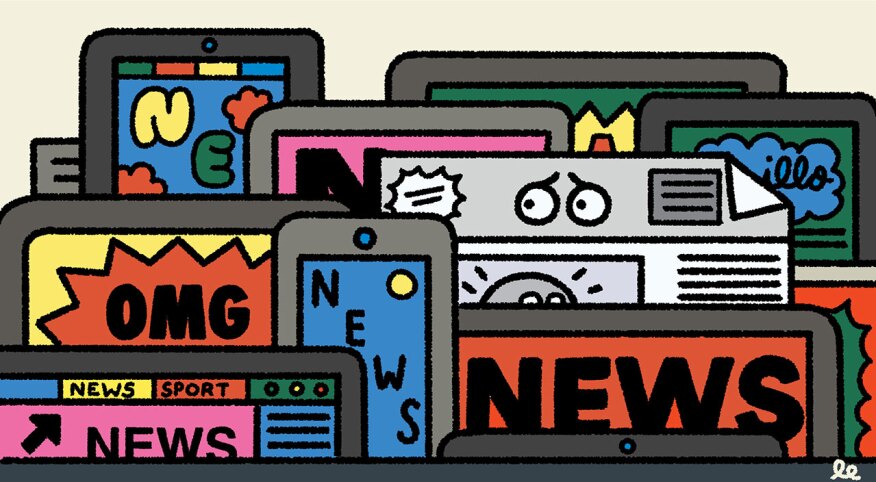I tried to buy a newspaper. Print newspapers and magazines that I subscribe to still arrive at my door, but I needed a specific article in USA Today, the national newspaper I don’t read daily. I’d published an opinion essay, and since it was behind a paywall, I wanted a physical copy. Just one, not an extended commitment.
I hadn’t been to a newsstand in ages and was surprised to find that my neighborhood kiosk carried only three newspapers — but lots of candy, cigarettes and e-cigarettes, water bottles, hats, nuts and rolling papers. I walked to two other stands nearby; neither was open.
It was nearly noon.
Didn’t anyone need a morning newspaper? I know, everyone was instead scanning their smartphones, with quick reads on the global pandemic, wars and what the Duchess of Sussex wore to the grocery store — before getting out of bed. But where are the readers like me, those who understood the significance of long, well-crafted articles, savored at breakfast with a cup or two of coffee?
I trekked to eight newsstands within a mile radius of my apartment. Only one had my desired paper. “Sold out,” the owner said. I’d waited in line while five people purchased Lotto tickets, replacing the quest for news with improbable dreams of riches. I could have bought Financial Times, but I wanted to be informed, not depressed.
More than 8 in 10 Americans now get their news from digital devices, according to a September 2020 survey by the Pew Research Center. I’m in the silent minority, still washing black print off my fingers after reading my home-delivered New York Times.
Digital news media grants us immediate information, but not always with substance. The decimation of local newspapers and what they covered is “an existential threat facing local watchdog journalism,” warns Pen America, an organization dedicated to protecting free expression.
Eventually I found the copy of USA Today I was searching for — 225 miles away. I texted a friend in Bethesda, Maryland, and she drove five miles, securing one last copy. She put it in the mail as if sending me a gift. Knowing how the USPS is operating, I should receive it by my birthday, 2022.
Another friend admonishes me for reading dead-tree editions. Yet I remain steadfast in my desire to select what I want to read rather than have an algorithm decide for me “the top 10 stories of the day.” Perusing an actual newspaper allows me to discover stories I might have missed.
My father read three newspapers a day. Before work: The New York Times and The Wall Street Journal. When we picked him up at the Sheepshead Bay subway station, he’d fetch a copy of the World-Telegram and Sun (defunct since 1966).
“Don’t bother him,” my mother warned before dinner was served. Instead of an appetizer or an aperitif, his pre-meal ritual was examining the closing Dow Jones average. His mood at dinner depended on whether IBM or Lincoln National were up or down.
Sunday mornings my parents rose at 5 a.m. to sign in at Dyker Public Golf Course, and during the five-hour wait to tee off, they’d return home with the thick Sunday Times and a bag of hot bagels. My older brothers, Yankees and Brooklyn Dodgers fans, respectively, always chose opposite sides; one read The New York Post, the other, The Daily News — steps up from their devotion to Mad Magazine.
When I took the subway with my father, he taught me how to fold a newspaper into quadrants in order to read without elbowing neighboring riders. Once I reached over to pick up someone’s discarded newspaper on an empty seat, and my mother sharply pulled me away, warning, “Never touch anyone else’s newspaper.” Her expression screamed: germs.
I couldn’t imagine a leftover newspaper making me ill, although after the pandemic, I’m starting to think my mother might have been right.
My parents never experienced today’s 24/7 news cycle. Instead, they taught me the importance of an article placed “above the fold.” Gone are the days of a Broadway theater opening and waiting until morning to see the reviews. Patience and the element of anticipated surprise are history.
Will iconic journalism movies like His Girl Friday and All the President’s Men soon feel like grandma flicks? Movie shots of presses rolling and papers piling up are as foreign to millennials as black-and-white TV. No wonder my daughter found Citizen Kane a snooze.
I will always miss the ritual of going out every Saturday night with my husband to a whimsical West Village place called Art and Ice Cream. We ate hot fudge sundaes, with homemade ice cream crafted by a nameless mystery woman in Little Italy. The owners’ paintings and other local artists’ work were for sale, decorating the walls like a museum—an array of penetrating portraits, neighborhood landscapes, and a few colorful abstract paintings.
On the way home, we’d always stop at the same newsstand to buy the first edition of Sunday’s New York Times. There were no lottery tickets for sale, but we felt lucky anyway, knowing we’d settle in to read the next day’s news before midnight.

Leon Edler





